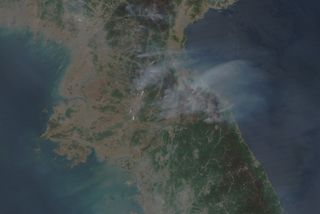North Korea Fires Seen from Space

Dozens of fires burning in secretive North Korea are visible on a new satellite image.
The Moderate Resolution Imaging Spectroradiometer on NASA's Aqua satellite caught this snapshot of fires burning in both agricultural and wilderness areas on the Korean Peninsula. Farmers in North Korea use fire to clear away last year's agricultural debris and prepare the land for a new crop, according to NASA's Earth Observatory. Wildfires in mountainous regions may be sparked by downed power lines.
Satellite images are one of the few ways the outside world can peek into North Korea, which is largely cut off from the outside world because of the totalitarian regime that rules the country. [7 Strange Cultural Facts About North Korea]
Isolated Nation
Another recent image of the country from space showed the country at night, almost completely dark. Only the capital city of Pyongyang shows signs of life in the image, illustrating the relative poverty of North Korea compared to its neighbors. In 2011, per-capita power consumption in the country was 729 kilowatt hours, compared to 10,162 kilowatt hours in South Korea, according to the World Bank.
The driving philosophy of North Korea's familial dictatorship is juche, or self-reliance. The first president of the regime, Kim Il Sung, cut off diplomatic and economic ties from the rest of the world after a failed United Nations attempt to reunify North and South Korea in 1948.
In the time since, the dynasty, now headed by Kim Jong Un, grandson of Kim Il Sung, has cultivated an aura of mythology about its leaders. State media, for example, claimed that Kim Il Sung could control the weather. When Kim Jong Il, the previous leader of North Korea, died in 2011, state news channels reported that the sky glowed red above Mount Paektu, a sacred mountain in North Korea.
Sign up for the Live Science daily newsletter now
Get the world’s most fascinating discoveries delivered straight to your inbox.
Approximately 120,000 people labor in political prison camps in North Korea, according to a recent Reuters report. The U.N. Human Rights Council this week called on the country to dismantle the camps and end the country's caste system, which ranks families in order of their political loyalty, Reuters said. The calls seem likely to fall on deaf ears: A North Korean assemblyman insisted that the political camps do not exist.
In 2013, human rights group Amnesty International released a new assessment of the camps, including satellite images that seem to show the prison communities expanding. Many detainees are kept only because their families are found guilty of political disloyalty, according to Amnesty, and the North Korean system punishes entire families for a single person's "crimes."
Follow Stephanie Pappas on Twitter and Google+. Follow us @livescience, Facebook & Google+. Original article on Live Science.

Stephanie Pappas is a contributing writer for Live Science, covering topics ranging from geoscience to archaeology to the human brain and behavior. She was previously a senior writer for Live Science but is now a freelancer based in Denver, Colorado, and regularly contributes to Scientific American and The Monitor, the monthly magazine of the American Psychological Association. Stephanie received a bachelor's degree in psychology from the University of South Carolina and a graduate certificate in science communication from the University of California, Santa Cruz.
